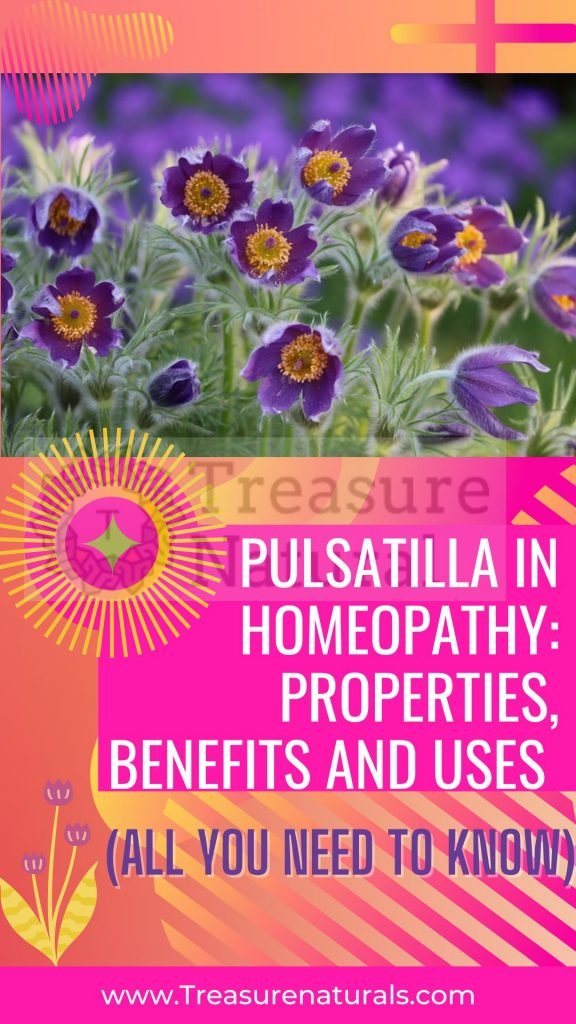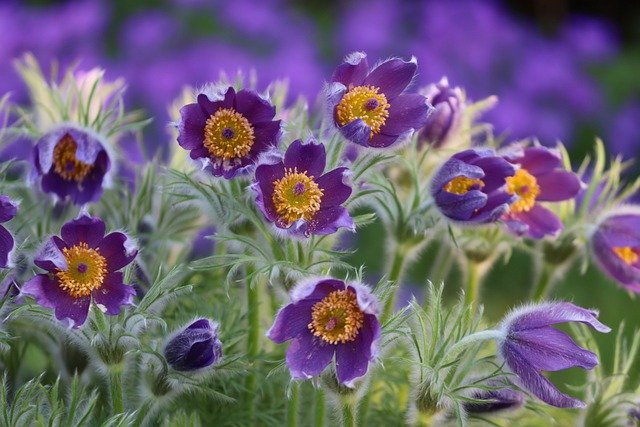
Pulsatilla is considered a subgenus of anemone and is widely used in Homeopathy thanks to its healing properties: it has mainly a sedative and analgesic action, but it can also be used to calm premenstrual and its typical symptoms: headache, swollen belly, abdominal pain, etc. Homeopathic therapies based on Pulsatilla are also used for those pathologies related to the yellow and green color, such as in the case of colds, sinusitis, asthma, migraine, indigestion, heartburn, mood swings, anxiety and depression.
Pulsatilla : the plant
The term Pulsatilla refers to a genus of perennial deciduous herbaceous plants, to which about thirty species of plants belong. The Pulsatilla is widespread in mountain habitats typical of North America and Eurasia: stony grasslands, meadows and subalpine pastures represent its preferred growth habitat.
The Pulsatilla is also known as the “Easter flower“, as the inflorescences appear during the Easter holidays; other common names of this herbaceous plant are: “grass of the wind” and “crocus of the parts”.
The best known and most used species also in Homeopathy is the Pulsatilla vulgaris: the plant is characterized by the presence of dark purple bell-shaped flowers with the orange central area and with leaves covered by a thin silvery down. The name derives precisely from the down of the plant, which in the wind almost seems to pulsate.
Pulsatilla: medical uses
Pulsatilla has always been used in Europe and America for medicinal purposes. However, actually reliable pharmacological studies began only towards the end of the twentieth century.
As mentioned above, there are different species of Pulsatilla: the root of the chinensis species, better known as Chinese anemone, is used in folk medicine as an intestinal disinfectant and antipyretic and must be prescribed by the doctor.
In addition, in the past, it was customary to exploit the medicinal virtues of Pulsatilla also to treat phlegm (expectorant property) and to relieve states of anxiety and restlessness (sedative virtue).
Pulsatilla: properties of the plant
Pulsatilla is a plant with many properties as it is rich in:
- anemonin, alkaloid responsible for the yellow coloration of the essential extract: the liquid characterized by anemonin is extremely volatile, burning and very irritating to the ocular and nasal mucous membranes. It is precisely this molecule that attributes to Pulsatilla the antispasmodic properties and therefore makes it useful in the treatment of digestive spasms, spasmodic cough and female genital pain.
- protoanemonin: the latter molecule is exploited for antibacterial, antifungal and bladder.
Despite the many properties it is advisable to pay close attention in the use of the plant. Pulsatilla extract is highly irritating: in this regard, it must be carefully diluted for oral administration, as well as for topical application.
Pulsatilla: homeopathic remedy
Pulsatilla is used in Homeopathy to treat a large number of ailments. Depending on the symptom you want to treat, you will have different preparations and dosages.
The homeopathic preparation of Pulsatilla uses the Mother Tincture, obtained by macerating in alcohol the plant collected at the time of flowering, from which progressive dilutions are carried out. Generally, the lowest dilutions are used for transient and isolated disorders, while the higher ones are used to treat chronic disorders.
Pulsatilla helps to improve symptoms due to problems with:
- mucous membranes: promotes the improvement of disorders that cause mucous secretions of greenish-yellow color, as in the case of colds or ocular conjunctivitis.
- circulation: very useful in case of varicose veins, phlebitis, swollen and sore legs and hands, chilblains.
- digestion: helps in case of slow and difficult digestion, swollen and sore abdomen, acidity and heartburn, hemorrhoids.
- breathing: it is very useful in case of bronchial asthma, especially if due to allergic problems. It promotes the expectoration of the mucus in case of congestion, helping to treat colds, flu, bronchitis and other respiratory diseases. In the case of subjects of the Pulsatilla type, the symptoms related to these problems improve in the open air.
- Genitourinary system: it is a valid aid for emotional urinary incontinence, especially in children who tend to pee in bed. In women it is very effective to improve the symptoms of premenstrual syndrome and to regulate the menstrual cycle. In lactating women it promotes the physiological production and secretion of milk. It is also useful in men suffering from orchitis, epididymitis or testicular neuralgia.
- nervous system: it represents an effective remedy for insomnia, hypochondriac depression, anxiety. It helps to relieve headaches due to the menstrual cycle, indigestion, catarrhal clogging.
- ears: pain in the ears and otitis
- eyes: prevents infections of the ocular conjunctiva, characterized by burning, itching, yellowish secretions.
Pulsatilla in pregnancy
Despite the many beneficial properties of this remedy, excessive doses of Pulsatilla extract could cause vomiting and/or diarrhea.
Exceeding the prescribed dosage, taking Pulsatilla could generate more serious ailments.
Therefore, in pregnancy, taking Pulsatilla is advisable to be carried out only under strict medical supervision.
Pulsatilla: constitutional type

Pulsatilla corresponds to a constitutional type (predominantly female) characterized by:
- nervous lability;
- indecision;
- easy crying;
- menstrual disorders;
- lack of self-confidence;
- shyness.
Although the constitutional type Pulsatilla is associated with the female gender, in reality this remedy is also indicated for men, if the morbid conditions typical of the remedy can be found.
From the physical point of view this subject has an almost marble appearance, with pale skin to the point of making the venous network shine through, light hair and eyes, often circled by purplish dark circles.
From the psychic point of view, however, Pulsatilla has a sweet and submissive character, shy, emotional but easily irritable and susceptible. He presents an underlying sadness, thus seeking the consolation and companionship of others: he is not an autonomous subject, but lives continuously of “sap” of others, attaching himself neurotically, conflictually, childishly to all those who will provide him with love and understanding.






